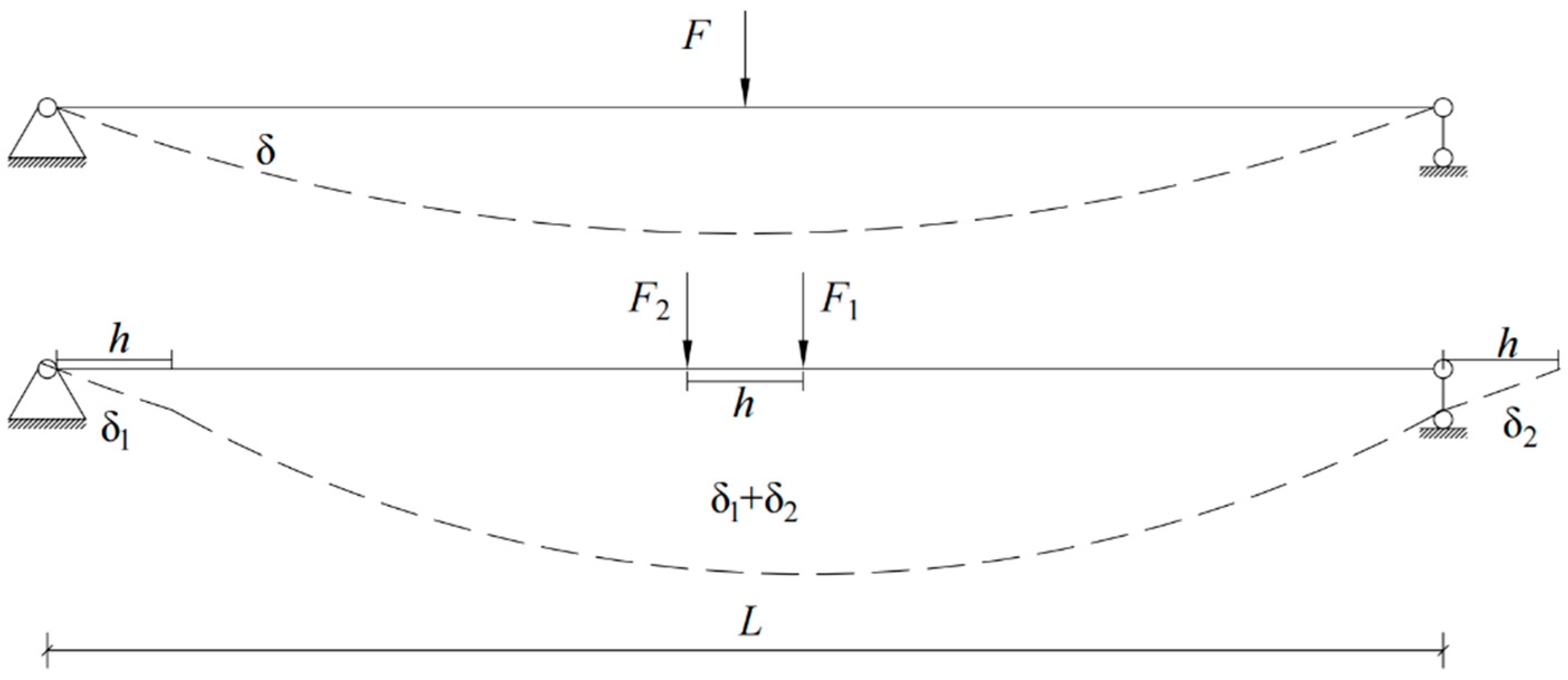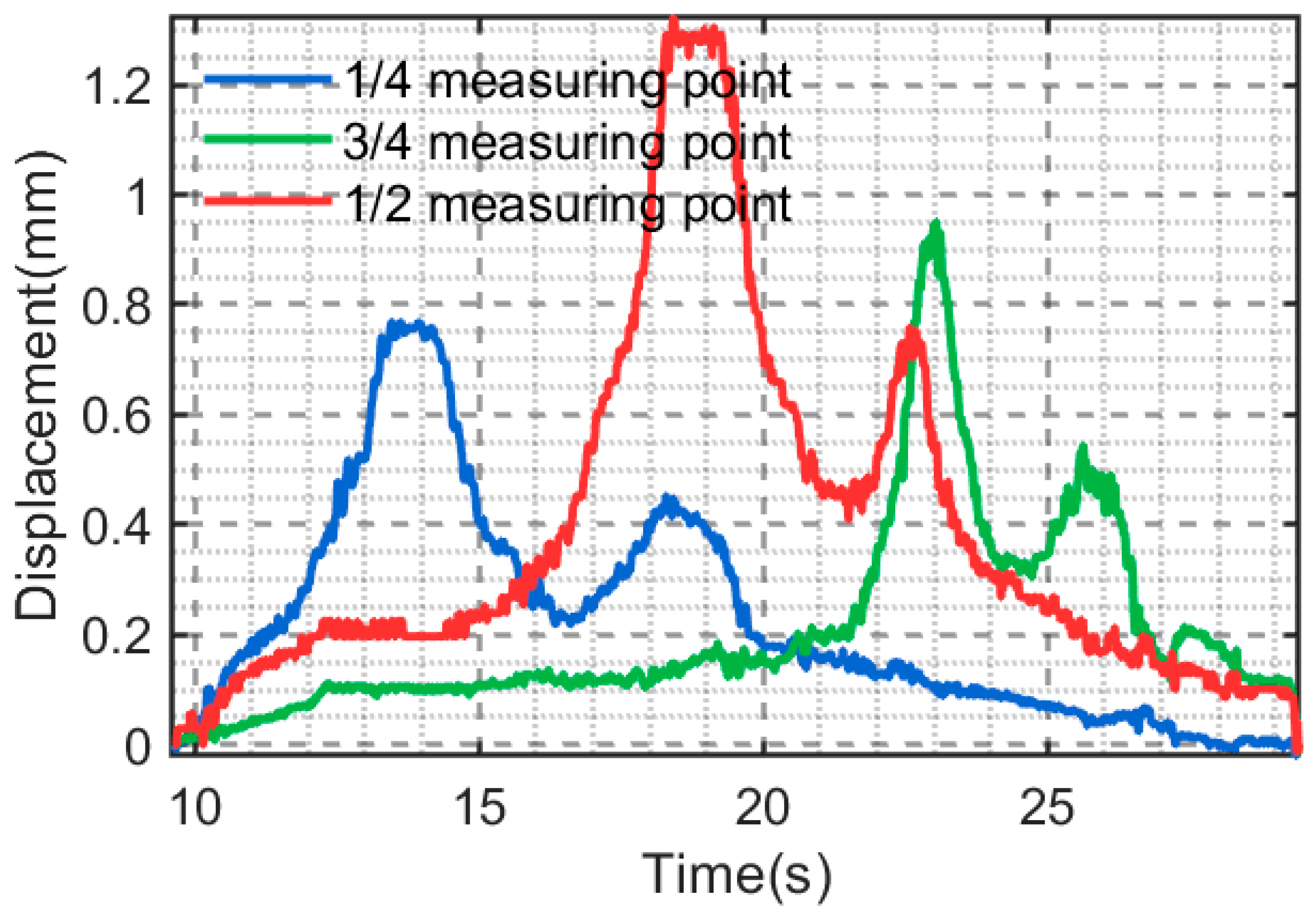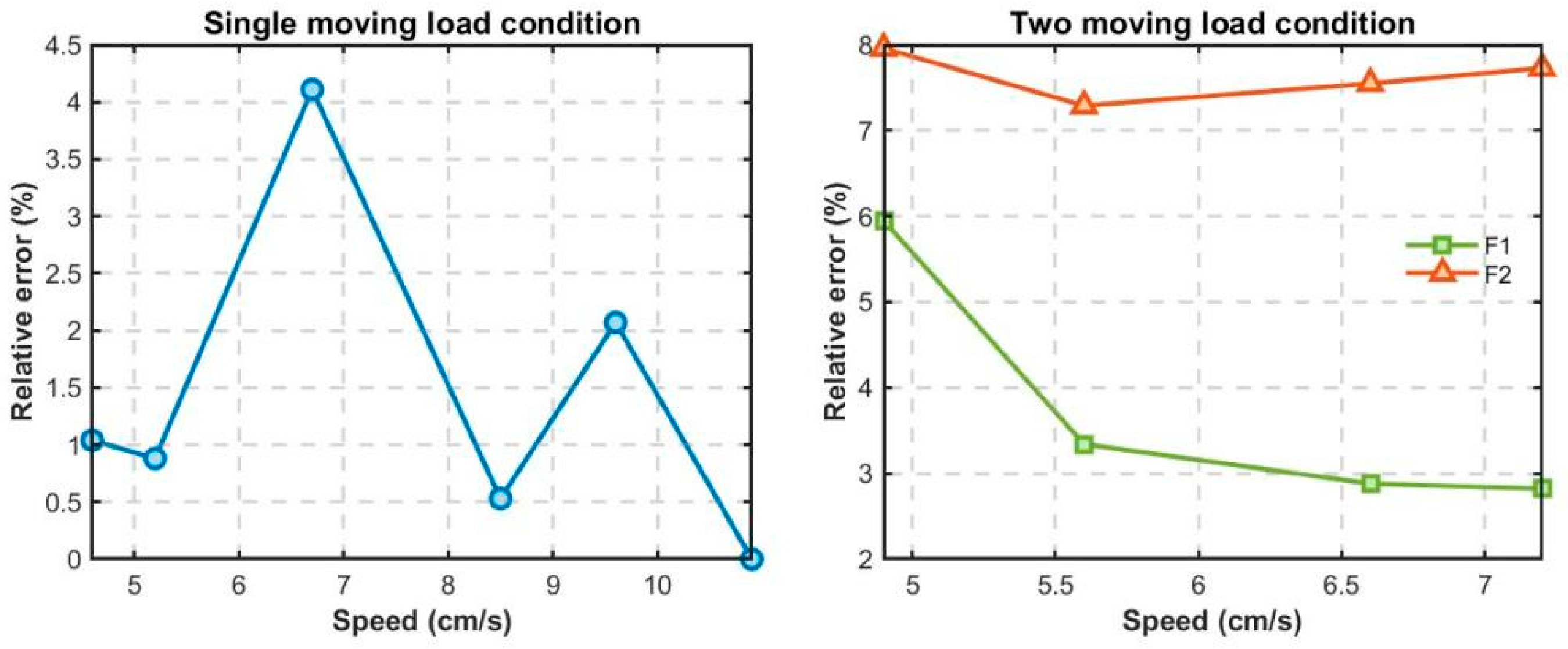A New Approach for Multiple Loads Identification Based on the Segmental Area of the Influence Lines
Abstract
1. Introduction
2. Theory on the Segmental Area of the Influence Lines
3. Experimental Setup
4. Data Analysis
4.1. Analysis of the Original Test Data with Single Load
4.2. Analysis of the Original Test Data with Two Moving Loads
5. Discussion
5.1. Comparison Between Theoretical and Actual Displacement Response
5.2. Relationship Between Identification Results and Load Speed
6. Conclusions
Author Contributions
Funding
Data Availability Statement
Conflicts of Interest
References
- Chris, K.; Rodney, B.; Peter, F. Australian High Speed Weigh-in-Motion: An Overview; Proc. Conf.; University of Michigan Transportation: Ann Arbor, MI, USA, 1995; pp. 143–151. Available online: https://trid.trb.org/View/642101 (accessed on 5 September 2025).
- Zhu, X.Q.; Law, S.S. Dynamic axle and wheel loads identification: Laboratory studies. J. Sound Vib. 2003, 268, 855–879. [Google Scholar] [CrossRef]
- Aloisio, A.; Alaggio, R.; Fragiacomo, M. Time-domain identification of the elastic modulus of simply supported box girders under moving loads: Method and full-scale validation. Eng. Struct. 2020, 215, 110619. [Google Scholar] [CrossRef]
- Liu, R.; Dobriban, E.; Hou, Z.; Qian, K. Dynamic Load Identification for Mechanical Systems: A Review. Arch. Comput. Methods Eng. 2022, 29, 831–863. [Google Scholar] [CrossRef]
- Mazumder, R.; Hastie, T.; Tibshirani, R. Spectral regularization algorithms for learning large incomplete matrices. J. Mach. Learn. Res. 2010, 11, 2287–2322. Available online: https://www.jmlr.org/papers/volume11/mazumder10a/mazumder10a.pdf (accessed on 7 September 2025).
- Khodarahmi, M.; Maihami, V. A review on Kalman filter models. Arch. Comput. Methods Eng. 2023, 30, 727–747. [Google Scholar] [CrossRef]
- Guo, T.; Zhang, T.; Lim, E.; López-Benítez, M.; Ma, F.; Yu, L. A review of wavelet analysis and its applications: Challenges and opportunities. IEEE Access 2022, 10, 58869–58903. [Google Scholar] [CrossRef]
- Law, S.S.; Chan, T.H.T.; Zeng, Q.H. Moving force identification: A time domain method. J. Sound Vib. 1997, 201, 1–22. [Google Scholar] [CrossRef]
- Law, S.S.; Chan, T.H.T.; Zeng, Q.H. Moving force identification—A frequency and time domains analysis. J. Dyn. Syst. Meas. Control 1999, 121, 394–401. [Google Scholar] [CrossRef]
- Li, M.; Wang, L.; Luo, C.; Wu, H. A new improved fractional Tikhonov regularization method for moving force identification. Structures 2024, 60, 105840. [Google Scholar] [CrossRef]
- Wang, L.; Peng, Y.; Xie, Y.; Chen, B.; Du, Y. A new iteration regularization method for dynamic load identification of stochastic structures. Mech. Syst. Signal Process. 2021, 156, 107586. [Google Scholar] [CrossRef]
- Jiang, J.; Cui, W.; Chen, S.; Guo, X.; Zhao, J. A novel dynamic load identification method based on improved basis functions and implicit Newmark-β for continuous system with unknown initial conditions. Mech. Syst. Signal Process. 2024, 208, 110987. [Google Scholar] [CrossRef]
- Jiang, J.; Ding, M.; Li, J. A novel time-domain dynamic load identification numerical algorithm for continuous systems. Mech. Syst. Signal Process. 2021, 160, 107881. [Google Scholar] [CrossRef]
- Wang, L.; Liu, Y. A novel method of distributed dynamic load identification for aircraft structure considering multi-source uncertainties. Struct. Multidiscip. Optim. 2020, 61, 1929–1952. [Google Scholar] [CrossRef]
- Li, Y.; Luo, Y.; Wan, H.-P.; Yun, C.-B.; Shen, Y. Identification of earthquake ground motion based on limited acceleration measurements of structure using Kalman filtering technique. Struct. Control Health Monit. 2020, 27, e2464. [Google Scholar] [CrossRef]
- Li, K.; Xiao, L.; Liu, M.; Kou, Y.; Wu, W. Structured Bayesian framework for distributed dynamic load identification: Exploiting joint sparsity and spatial correlation priors. Mech. Syst. Signal Process. 2025, 238, 113180. [Google Scholar] [CrossRef]
- Liu, Y.; Wang, L.; Ng, B.F. A hybrid model-data-driven framework for inverse load identification of interval structures based on physics-informed neural network and improved Kalman filter algorithm. Appl. Energy 2024, 359, 122740. [Google Scholar] [CrossRef]
- Ji, Y.; Huang, Y.; Zeng, J.; Ren, L.; Chen, Y. A physical–data-driven combined strategy for load identification of tire type rail transit vehicle. Reliab. Eng. Syst. Saf. 2025, 253, 110493. [Google Scholar] [CrossRef]
- Yang, H.; Jiang, J.; Chen, G.; Zhao, J. Dynamic load identification based on deep convolution neural network. Mech. Syst. Signal Process. 2023, 185, 109757. [Google Scholar] [CrossRef]
- Wang, C.; Chen, D.; Chen, J.; Lai, X.; He, T. Deep regression adaptation networks with model-based transfer learning for dynamic load identification in the frequency domain. Eng. Appl. Artif. Intell. 2021, 102, 104244. [Google Scholar] [CrossRef]
- Song, H.; Shan, X.; Zhang, L.; Wang, G.; Fan, J. Research on identification and active vibration control of cantilever structure based on NARX neural network. Mech. Syst. Signal Process. 2022, 171, 108872. [Google Scholar] [CrossRef]
- Huang, M.; Zhang, J.; Li, J.; Deng, Z.; Luo, J. Damage Identification of Steel Bridge Based on Data Augmentation and Adaptive Optimization Neural Network. Struct. Health Monit. 2024, 24, 1674–1699. [Google Scholar] [CrossRef]
- Huang, M.; Wan, N.; Zhu, H. Reconstruction of structural acceleration response based on CNN-BiGRU with squeeze-and-excitation under environmental temperature effects. J. Civ. Struct. Health Monit. 2025, 15, 985–1003. [Google Scholar] [CrossRef]
- Huang, M.; Zhang, J.; Hu, J.; Ye, Z.; Deng, Z.; Wan, N. Nonlinear Modeling of Temperature-Induced Bearing Displacement of Long-Span Single-Pier Rigid Frame Bridge Based on DCNN-LSTM. Case Stud. Therm. Eng. 2024, 53, 103897. [Google Scholar] [CrossRef]
- Zhang, J.; Huang, M.; Wan, N.; Deng, Z.; He, Z.; Luo, J. Missing Measurement Data Recovery Methods in Structural Health Monitoring: The State, Challenges and Case Study. Measurement 2024, 231, 114528. [Google Scholar] [CrossRef]
- Wei, Y.-T.; Yang, D.-H.; Yi, T.-H.; Li, H.-N.; Zhou, P.; Xue, X.-W. Bridge static influence line identification based on structural dynamic responses under high-speed trains. Int. J. Struct. Stab. Dyn. 2023, 23, 2350126. [Google Scholar] [CrossRef]
- Moslehi, A.T.; Tsavdaridis, K.D.; Bravo-Haro, M. Identification of high-speed moving loads using weakened modal shape functions conceptualised by the dynamic influence line. Structures 2025, 74, 108549. [Google Scholar] [CrossRef]
- Zhu, J.; Zhang, C.; Li, X. Structural damage detection of the bridge under moving loads with the quasi-static displacement influence line from one sensor. Measurement 2023, 211, 112599. [Google Scholar] [CrossRef]
- Yang, J.; Hou, P.; Yang, C.; Zhang, Y. Study on the method of moving load identification based on strain influence line. Appl. Sci. 2021, 11, 853. [Google Scholar] [CrossRef]
- Xu, W. Vehicle load identification using machine vision and displacement influence lines. Buildings 2024, 14, 392. [Google Scholar] [CrossRef]
- Deng, L.; Wu, H.; He, W.; Ling, T.; Liu, G. Genuine influence line and influence surface identification from measured bridge response considering vehicular wheel loads. J. Bridge Eng. 2023, 28, 04022145. [Google Scholar] [CrossRef]
- Purwanto, A.; Sudargini, Y. Partial least squares structural equation modeling (PLS-SEM) analysis for social and management research: A literature review. J. Ind. Eng. Manag. Res. 2021, 2, 114–123. Available online: https://jiemar.org/index.php/jiemar/article/view/168/130 (accessed on 12 November 2025).
- Schmid, M.; Rath, D.; Diebold, U. Why and how Savitzky–Golay filters should be replaced. ACS Meas. Sci. Au 2022, 2, 185–196. [Google Scholar] [CrossRef] [PubMed]
- Rivlin, T.J. Chebyshev Polynomials; Courier Dover Publications: New York, NY, USA, 2020; Available online: https://books.google.com.hk/books?id=rPLwDwAAQBAJ (accessed on 8 September 2025).














| Case ID | Details | Remarks | |
|---|---|---|---|
| Speed (m/s) | Moving Load (N) | ||
| A1 | 0.046 | 50 | A6 defined as a calibration case |
| A2 | 0.052 | ||
| A3 | 0.067 | ||
| A4 | 0.085 | ||
| A5 | 0.096 | ||
| A6 | 0.109 | ||
| B1 | 0.049 | 50, 19.4 | |
| B2 | 0.056 | ||
| B3 | 0.066 | ||
| B4 | 0.072 | ||
| Case | Monitoring Data Coverage Area | Ratio to Calibration Load | Average Ratio | Calculated Load (N) | Actual Load (N) | Error % | Uncertainty % | ||||
|---|---|---|---|---|---|---|---|---|---|---|---|
| 1/4 | 1/2 | 3/4 | |||||||||
| A1 | 0.1805 | 0.3505 | 0.2490 | 1.01 | 1.00 | 1.03 | 1.01 | 50.52 | 50.0 | 1.04 | 0.5 |
| A2 | 0.1752 | 0.3381 | 0.2509 | 0.98 | 0.96 | 1.03 | 0.99 | 49.56 | −0.88 | 0.4 | |
| A3 | 0.2054 | 0.3566 | 0.2470 | 1.09 | 1.02 | 1.02 | 1.04 | 52.05 | 4.11 | 0.7 | |
| A4 | 0.1883 | 0.3409 | 0.2415 | 1.05 | 0.97 | 0.99 | 1.01 | 50.27 | 0.53 | 0.9 | |
| A5 | 0.1861 | 0.3498 | 0.2495 | 1.04 | 1.00 | 1.03 | 1.02 | 51.04 | 2.07 | 0.3 | |
| A6 | 0.1793 | 0.3508 | 0.2429 | NA | |||||||
| Case | Crest Timing Difference (s) | Speed (m/s) | Calculate Distance h (m) | Unit Distance h0 | Actual Distance (m) | Error % |
|---|---|---|---|---|---|---|
| B1 | 5.29 | 0.049 | 0.259 | 0.2161 | 0.25 | 3.6 |
| B2 | 4.45 | 0.056 | 0.249 | 0.2071 | −0.4 | |
| B3 | 3.95 | 0.066 | 0.261 | 0.2171 | 4.4 | |
| B4 | 3.56 | 0.072 | 0.256 | 0.2135 | 2.5 |
| Case | Measuring Point Location | Calculated Values | ||||||
|---|---|---|---|---|---|---|---|---|
| δ1 | δ2 | δ3 | δ4 | D1 | D2 | D3 | ||
| B1 | 1/4 | 0.0500 | 0.1343 | 0.1719 | 0.0128 | 0.0529 | 0.2057 | 0.0635 |
| 1/2 | 0.0311 | 0.3332 | 0.3213 | 0.0429 | 0.0325 | 0.4582 | 0.0155 | |
| 3/4 | 0.0159 | 0.2244 | 0.1761 | 0.0635 | 0.0171 | 0.3045 | 0.0237 | |
| B2 | 1/4 | 0.0444 | 0.1399 | 0.1725 | 0.0122 | 0.049 | 0.2171 | 0.0605 |
| 1/2 | 0.0292 | 0.3351 | 0.3239 | 0.0403 | 0.0278 | 0.4318 | 0.0152 | |
| 3/4 | 0.0148 | 0.2253 | 0.1828 | 0.0569 | 0.0155 | 0.3026 | 0.0211 | |
| B3 | 1/4 | 0.0506 | 0.1336 | 0.1718 | 0.0122 | 0.0549 | 0.2061 | 0.062 |
| 1/2 | 0.0292 | 0.3351 | 0.3239 | 0.0403 | 0.0329 | 0.4629 | 0.0162 | |
| 3/4 | 0.0160 | 0.2242 | 0.1752 | 0.0643 | 0.0152 | 0.2776 | 0.024 | |
| B4 | 1/4 | 0.0487 | 0.1356 | 0.1720 | 0.0127 | 0.0468 | 0.2042 | 0.0708 |
| 1/2 | 0.0307 | 0.3336 | 0.3219 | 0.0423 | 0.0301 | 0.4615 | 0.0167 | |
| 3/4 | 0.0157 | 0.2246 | 0.1776 | 0.0619 | 0.0153 | 0.2966 | 0.0261 | |
| Case | Moving Load | Ratio to Calibration Load | Average Ratio | Calculated Load (N) | Actual Load (N) | Error % | Uncertainty % | ||
|---|---|---|---|---|---|---|---|---|---|
| 1/4 | 1/2 | 3/4 | |||||||
| B1 | F1 | 1.06 | 1.04 | 1.08 | 1.06 | 52.97 | 50.0 | 5.95 | 0.4 |
| F2 | 0.37 | 0.34 | 0.36 | 0.36 | 17.86 | 19.4 | −7.96 | 0.5 | |
| B2 | F1 | 1.10 | 0.95 | 1.05 | 1.03 | 51.67 | 50.0 | 3.34 | 0.5 |
| F2 | 0.36 | 0.35 | 0.37 | 0.36 | 17.99 | 19.4 | −7.29 | 0.4 | |
| B3 | F1 | 1.09 | 1.05 | 0.95 | 1.03 | 51.44 | 50.0 | 2.88 | 0.6 |
| F2 | 0.36 | 0.35 | 0.37 | 0.36 | 17.94 | 19.4 | −7.55 | 0.7 | |
| B4 | F1 | 0.96 | 0.98 | 0.97 | 0.97 | 48.59 | 50.0 | −2.82 | 0.5 |
| F2 | 0.41 | 0.41 | 0.42 | 0.42 | 20.90 | 19.4 | 7.73 | 0.7 | |
Disclaimer/Publisher’s Note: The statements, opinions and data contained in all publications are solely those of the individual author(s) and contributor(s) and not of MDPI and/or the editor(s). MDPI and/or the editor(s) disclaim responsibility for any injury to people or property resulting from any ideas, methods, instructions or products referred to in the content. |
© 2025 by the authors. Licensee MDPI, Basel, Switzerland. This article is an open access article distributed under the terms and conditions of the Creative Commons Attribution (CC BY) license (https://creativecommons.org/licenses/by/4.0/).
Share and Cite
Liu, P.; Qiu, W.; Kaewunruen, S. A New Approach for Multiple Loads Identification Based on the Segmental Area of the Influence Lines. Infrastructures 2025, 10, 308. https://doi.org/10.3390/infrastructures10110308
Liu P, Qiu W, Kaewunruen S. A New Approach for Multiple Loads Identification Based on the Segmental Area of the Influence Lines. Infrastructures. 2025; 10(11):308. https://doi.org/10.3390/infrastructures10110308
Chicago/Turabian StyleLiu, Ping, Weiwei Qiu, and Sakdirat Kaewunruen. 2025. "A New Approach for Multiple Loads Identification Based on the Segmental Area of the Influence Lines" Infrastructures 10, no. 11: 308. https://doi.org/10.3390/infrastructures10110308
APA StyleLiu, P., Qiu, W., & Kaewunruen, S. (2025). A New Approach for Multiple Loads Identification Based on the Segmental Area of the Influence Lines. Infrastructures, 10(11), 308. https://doi.org/10.3390/infrastructures10110308







